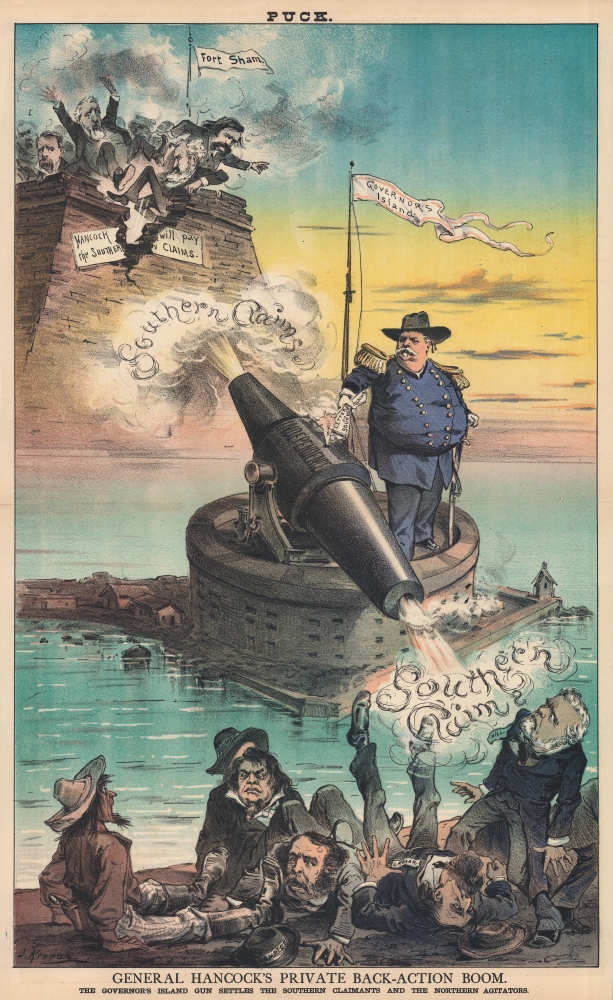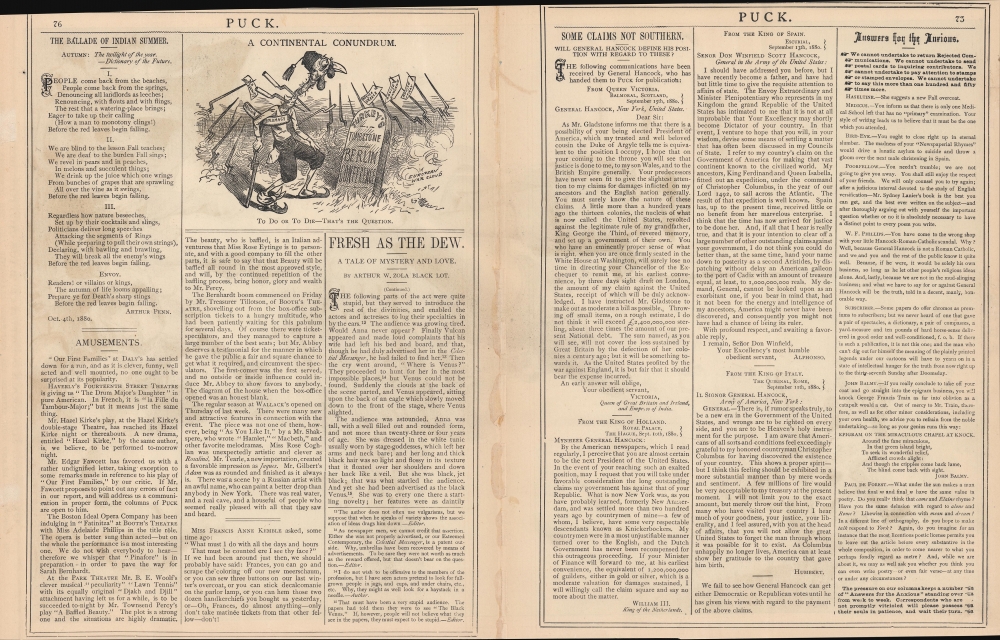1880 Keppler Political Cartoon of General Hancock Firing On His Critics and Allies
GeneralHancocksBoom-keppler-1880
Title
1880 (undated) 19.5 x 11.75 in (49.53 x 29.845 cm)
Description
A Closer Look
General Hancock (1824 - 1886), dressed in his Army uniform, stands to the right of center firing a cannon labeled 'Independence'. He holds tinder that reads 'Letter on Southern Claims' which ignites the incredible double-barreled cannon's fuse and fires on both his critics in 'Fort Sham' and on his allies in the foreground. Among these supposed friends are Robert Toombs (the former Confederate Secretary of State), Wade Hampton (a former Confederate and in 1880 a U.S. Senator from South Carolina), and Benjamin H. Hill (one of the founders of the first Ku Klux Klan and in 1880 a U.S. Senator from Georgia). His detractors occupy 'Fort Sham' which bears a sign that reads, 'Hancock will pay the Southern Claims'.Hancock and Southern Claims
As the 1880 Democratic nominee for President, Hancock carried the weight of the Democratic party's history. Among the rhetoric thrown about during the campaign, one claim was that Hancock, being a Democrat, would make certain all Southern Claims presented to the U.S. Congress, or the Southern Claims Commission would be approved. This outrage caused an uproar in the northern states, and Hancock issued a statement saying that any bill or document that came to him to sign that included Southern Claims would be vetoed. This statement, which was widely published, was not entirely believed by northern Republicans.Southern Claims
Beginning not long after the end of the American Civil War (1861 - 1865), southern Unionists (yes, there were a few) began petitioning the federal government for reimbursement of provisions they legitimately provided to the Union Army during the war. In 1871 the federal government created the Southern Claims Commission so that Unionists could apply for these reimbursements. Southerners from 12 states could apply and 22,298 claims were made. Of these 7,092 were paid. Today, these applications provide scholars with surprisingly detailed information about life in the South during the Civil War.Publication History and Census
This cartoon was drawn by Joseph Keppler and published by Puck in the October 6, 1880 issue. We have not found any cataloged examples in institutional collections and this cartoon is very scarce on the private market.Cartographer
Joseph Ferdinand Keppler (February 1, 1838 - February 19, 1894) was an immensely influential Austrian-born American caricaturist and cartoonist. Born in Vienna, Keppler studied art at the Academy of Fine Arts Vienna and contributed work to the Vienna-based comedy magazine Kikeriki. As he was unable to support himself only with his art, Keppler joined a theatrical troupe and acted as its scene painter and then as a comedian. He earned some extra money as the troupe traveled through the Tyrol and Italy by restoring old paintings in monasteries. He married Viennese actress Minna Rubens in 1864 and he and his wife soon emigrated to the United States to join Keppler's father, who had emigrated to the United States to escape the Revolutions of 1848 and was the proprietor of a general store in northern Missouri. By 1867, Keppler and his wife had settled in St. Louis, where Keppler was working as an actor. He helped start the German-American cartoon weekly Die Vehme in 1869. Die Vehme survived for a year, and was followed by Frank und Frei, which lasted only six months. Keppler founded Puck in St. Louis in March 1871, though this iteration of the magazine only lasted until August 1872. Minna died in 1870, and Keppler married Pauline Pfau in 1871, with whom he had three children. Keppler and his wife moved to New York City in 1872, where he found work in Frank Leslie's publishing house, and Keppler began contributing cartoons to Frank Leslie's Illustrated Newspaper in 1874. Puck was restarted by Keppler and fellow Frank Leslie employee Adolph Schwarzmann in September 1876 for the German-American population in New York, and began printing an English-language edition the following year. Keppler's cartoons, particularly those criticizing President Ulysses S. Grant and his administration, began to generate attention and publicity for the magazine. Keppler's caustic wit and clever adaptations of classical and historical subjects became famous, as did their pioneering use of color lithography. Keppler published a special World's Fair Puck from the World's Columbian Exposition in Chicago during the summer of 1893, a strain that took a terrible toll on his health, and contributed to his death the following year in New York. More by this mapmaker...




